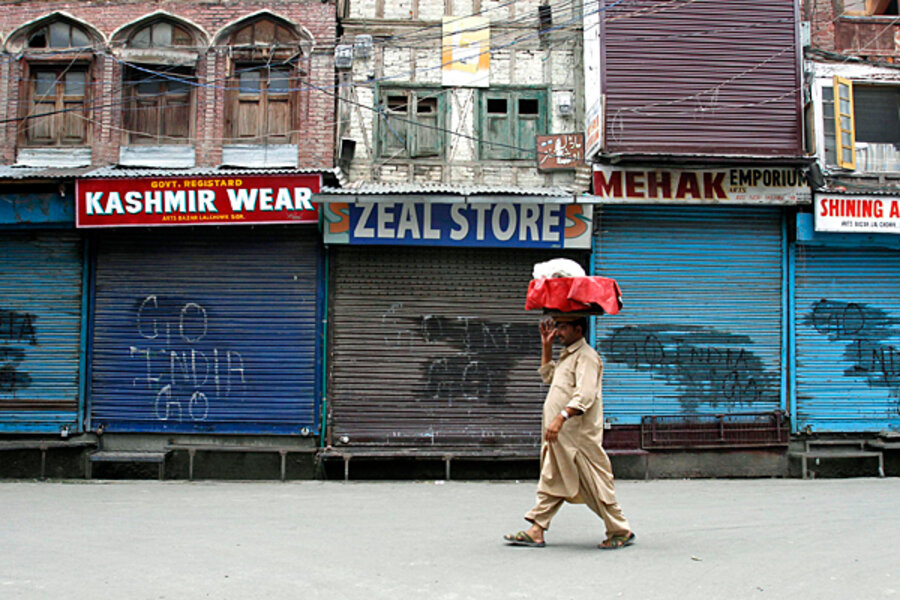India's top court orders roads for pilgrims through fragile territory
Loading...
| Srinagar, Indian-controlled Kashmir
The Indian Supreme Court is directing the government of the disputed region of Kashmir to construct a paved road through miles of a delicate mountain ecosystem in order to ensure the safety of throngs of Hindu pilgrims.
The court's ruling in August followed a summer in which 86 pilgrims died making the trek to the Amarnath cave, one of the holiest sites in Hinduism. An ice stalagmite forms inside the cave, located high up at 12,755 feet, that Hindus worship for its connection to the god Shiva. Health authorities blame the high altitude and cardiac arrest as the main reasons for pilgrim deaths.
Yet, the pilgrims remain undaunted with their numbers exploding in recent years, from fewer than 20,000 in 1980 to more than 600,000 this year. The influx has affected the ecology around the cave as well as the tourist towns of Pahalgam and Sonamarg. The surrounding glacier of Kolahoi has shrunk by just over a square mile, helped along by cracking created by the vibration of helicopters used to transport pilgrims. A paved road, say environmentalists, would attract yet more people, bringing further disruption to wildlife and strain on water sources.
The government has struggled to decide on a course of action because the pilgrimage has become a controversial political symbol for both Indian Hindus and Kashmiri Muslims. In 2008, mass protests erupted in the mostly-Muslim Kashmir Valley after a large patch of local land was handed over to a Shrine Board linked to the Indian-backed state government. More than 80 people were killed by Indian forces during the months of protests.
A land grab?
Parvez Imroz, a prominent human rights lawyer, says that the state government wanted to seize the land and start construction in 2008 but backed off after protests mounted. Now the court ruling, he argues, is giving them political cover to move ahead with the construction of road and occupying more land.
“The construction will have disastrous implications. In other religious sites, state and federal government have been very sensitive for ecology. But here they don’t,” says Mr. Imroz.
A study done by glaciologist Shakil Ramsoo called Climate Change, Glacial Retreat, and Livelihoods found that the Kolahoi glacier is shrinking 0.03 square miles a year because of the climate change and other factors such as the mass visits to Pahalgam.
“The mass influx of tourists and pilgrims can be another reason for playing havoc to the glacier. It is irrespective of the religion and region that around 1.8 million people who visit Pahalgam every year are degrading its ecology,” says Professor Shakil Ramsoo, HOD, Department of Earth Sciences, University of Kashmir.
Another report on Pahalgam had found that the piles of refuse left by pilgrims are contaminating local water sources, leading to health problems for local residents.
Court rules for roads
In its ruling, the court said that the “government cannot escape its obligation to provide minimum essential facilities including roads as an approach to the holy cave.”
The Advocate General of the state had said the government has accepted the court's decision "in principle" and is drawing up a work plan for next year's pilgrimage that it will submit to the court next month.
The state Chief Minister Omar Abdullah has ruled out construction of any concrete road to the Amarnath cave, arguing he can fulfill the court's mandate with minimal upgrades. "Only the track will be repaired and that too after getting the necessary clearance from the Forest Department and other concerned agencies," the Chief Minister said today.
The court decision and distrust of how the government will respond are generating outcry in the valley. Opponents of any road argue that a better solution would be to restrict the number of pilgrims. Indeed, a commission set up in 1996 to look at the problems from the crowds recommended that only 10,000 pilgrims be allowed to the cave per day.
“It is simply not possible to safely accommodate a number larger than 100,000 pilgrims during 30 day pilgrimage,” the commission had said at the time.
History leads to distrust
India and Pakistan both lay claim to Kashmir, now split along a heavily-militarized line of control. In 1989, Kashmiri separatists and Pakistani militants launched a violent uprising against Indian rule. Indian forces have extinguished the insurgency, but many Kashmiris in the Valley still protest without weapons for the right to self-determination.
Given this history, Kashmiris remain sensitive to any efforts by India to expand its writ over the region – especially control over land and its use.
A source in the Pahalgam Development Authority reveals that the pilgrimage's Shrine Board installed a temporary base camp in Pahalgam without any compensation to the Pahalgam Development Authority or locals.
“A more than 200 kanals [25 acres] of land patch has been occupied by the Shrine Board and they never paid any rent. In return, they charge locals for pitching tents or shops and earn revenue of around $9,300-11,200 every year,” says the source, who refused to be named for fear of the authorities. When the Pahalgam Development Authority wrote a letter to the board for paying rent, he says they replied: “Don’t interfere in our issues.”
Chief Executive Officer of the Amarnath Shrine Board Naveen K. Choudhary refused to comment on the Supreme Court order and the developments after it, saying: “I am not in a position to comment anything. You should talk to the government."
The separatist leaders smell a conspiracy in building roads or any structures for the pilgrimage as they believe it is India’s plan to change the demography of the region. India has been presenting the rising number of pilgrims to Kashmir as a “huge inflow of tourists” that demonstrates that peace has returned to Kashmir.
Separatist leader Syed Ali Geelani claims that the state government has already started construction in the pilgrimage area, releasing some photographic evidence.
“The Shrine Board has become a state within the state,” says Mr. Geelani. The Board, he says, should be dissolved and the caretaking of the pilgrimage should be handed over to Hindus from Kashmir, known as Pandits. “The number of pilgrims and the duration of the pilgrimage should be limited. The pilgrimage should not be used as a political weapon."






